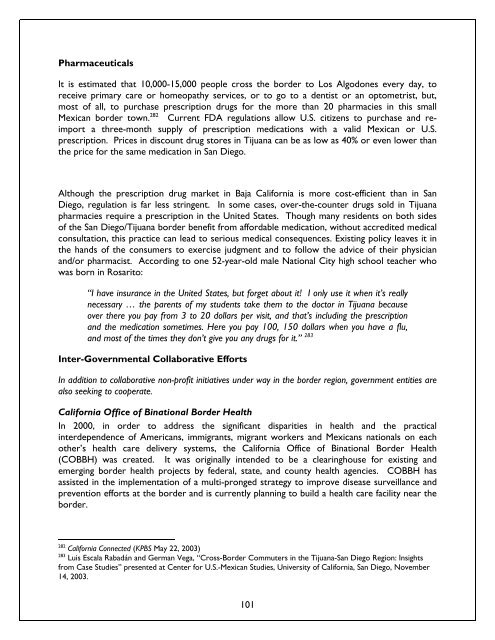Blurred Borders - International Community Foundation
Blurred Borders - International Community Foundation
Blurred Borders - International Community Foundation
Create successful ePaper yourself
Turn your PDF publications into a flip-book with our unique Google optimized e-Paper software.
Pharmaceuticals<br />
It is estimated that 10,000-15,000 people cross the border to Los Algodones every day, to<br />
receive primary care or homeopathy services, or to go to a dentist or an optometrist, but,<br />
most of all, to purchase prescription drugs for the more than 20 pharmacies in this small<br />
Mexican border town. 282 Current FDA regulations allow U.S. citizens to purchase and reimport<br />
a three-month supply of prescription medications with a valid Mexican or U.S.<br />
prescription. Prices in discount drug stores in Tijuana can be as low as 40% or even lower than<br />
the price for the same medication in San Diego.<br />
Although the prescription drug market in Baja California is more cost-efficient than in San<br />
Diego, regulation is far less stringent. In some cases, over-the-counter drugs sold in Tijuana<br />
pharmacies require a prescription in the United States. Though many residents on both sides<br />
of the San Diego/Tijuana border benefit from affordable medication, without accredited medical<br />
consultation, this practice can lead to serious medical consequences. Existing policy leaves it in<br />
the hands of the consumers to exercise judgment and to follow the advice of their physician<br />
and/or pharmacist. According to one 52-year-old male National City high school teacher who<br />
was born in Rosarito:<br />
“I have insurance in the United States, but forget about it! I only use it when it’s really<br />
necessary … the parents of my students take them to the doctor in Tijuana because<br />
over there you pay from 3 to 20 dollars per visit, and that’s including the prescription<br />
and the medication sometimes. Here you pay 100, 150 dollars when you have a flu,<br />
and most of the times they don’t give you any drugs for it.” 283<br />
Inter-Governmental Collaborative Efforts<br />
In addition to collaborative non-profit initiatives under way in the border region, government entities are<br />
also seeking to cooperate.<br />
California Office of Binational Border Health<br />
In 2000, in order to address the significant disparities in health and the practical<br />
interdependence of Americans, immigrants, migrant workers and Mexicans nationals on each<br />
other’s health care delivery systems, the California Office of Binational Border Health<br />
(COBBH) was created. It was originally intended to be a clearinghouse for existing and<br />
emerging border health projects by federal, state, and county health agencies. COBBH has<br />
assisted in the implementation of a multi-pronged strategy to improve disease surveillance and<br />
prevention efforts at the border and is currently planning to build a health care facility near the<br />
border.<br />
282 California Connected (KPBS May 22, 2003)<br />
283 Luis Escala Rabadán and German Vega, “Cross-Border Commuters in the Tijuana-San Diego Region: Insights<br />
from Case Studies” presented at Center for U.S.-Mexican Studies, University of California, San Diego, November<br />
14, 2003.<br />
101















